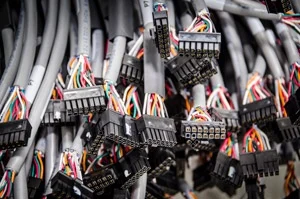When designing a custom cable assembly, it’s important to consider the many different factors that affect cost. Creating a prototype that both meets the needs of your application and is cost-effective to produce may seem like a difficult task, but the experts at JEM are here to break down the process and make it as easy as possible.
There are 3 key areas that need to be considered in your assembly design:
- Raw material selection
- Connector selection
- Ease of manufacturability
If all of these areas are optimized correctly in the design stage, you stand the best chance of keeping your manufacturing costs as low as possible.
Choose the Right Raw Materials
Raw materials account for a large percentage of a cable assembly’s costs. Matching the conductor, insulation, shielding and jacket material with the environment that the assembly will be used in is an important way to keep costs down. Matching the size of the conductor to the electrical requirements of the application in terms of voltage and ampacity needs will control costs. Using conductors with a higher stranding than is needed or with plating that is not warranted by the application will result in unnecessary added costs. For example, if the assembly will be installed in a stationary application, there is no need to design in flexible cables that significantly drive up costs (see more on the difference between solid vs stranded wire).
 The requirement for shielded vs unshielded cables depends on the type of signal that the assembly will transmit. This is an important consideration when designing a custom cable assembly. Shielding is available in different configurations ranging from single sided tapes with a metallic skin adhered to a base material like polyester up to braids consisting of metal strands woven around the cable core. The purpose of tapes is to offer EMI/RFI protection to either the components within the cable or the cable itself. A custom cable assembly design with more shielding than necessary or the wrong type of shielding can result in added costs.
The requirement for shielded vs unshielded cables depends on the type of signal that the assembly will transmit. This is an important consideration when designing a custom cable assembly. Shielding is available in different configurations ranging from single sided tapes with a metallic skin adhered to a base material like polyester up to braids consisting of metal strands woven around the cable core. The purpose of tapes is to offer EMI/RFI protection to either the components within the cable or the cable itself. A custom cable assembly design with more shielding than necessary or the wrong type of shielding can result in added costs.
Avoid Sole Sourced Connectors
 The connectors chosen for any given application need to match the form, fit, and function of the expected performance of the finished cable assembly. Try to avoid choosing a style of connector that is only produced by one single manufacturer. Choosing connectors that can be substituted with like connectors from different manufacturers helps to avoid future supply chain and pricing issues.
The connectors chosen for any given application need to match the form, fit, and function of the expected performance of the finished cable assembly. Try to avoid choosing a style of connector that is only produced by one single manufacturer. Choosing connectors that can be substituted with like connectors from different manufacturers helps to avoid future supply chain and pricing issues.
Design for Ease of Manufacturing
When designing a custom cable assembly, the desire to specify extremely tight tolerances should be avoided whenever possible. There are applications where a tight tolerance is required – such as when very specific electrical characteristics are needed or when the assembly is to be routed through a predetermined opening. In these instances, a tight tolerance is needed to ensure the assembly meets the application. In most applications, adherence to published standards is acceptable, such as IPC/WHMA-A-620.
Another helpful technique is using distinct and contrasting colored wires in the assembly, which makes the termination process more efficient and cost effective. This also aids in the visual inspection process during the customer’s incoming inspection. When choosing contrasting colors, avoid choosing light and dark shades of the same color (i.e. light blue, blue, dark blue).
If all of these factors are considered in the design stage, you stand the best chance of keeping the cost of a custom cable assembly as cost efficient as can be for your application.


